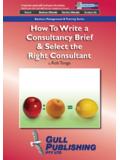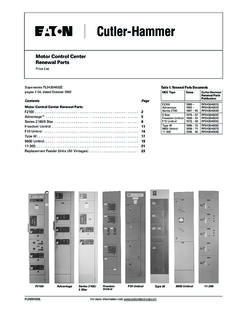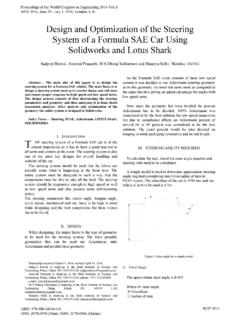Transcription of Business Management & Training Series How To Write ...
1 Business Management & Training SeriesBy Rob TongeHow To Write Training ManualsImprove yourself and your businessAdvance your career, train staff, learn new Management techniquesHomeBusiness ManualsTourism ManualsContact UsHow To Write Training Manuals2 HOMEB usiness ManualsTourism ManualsContact UsThank you for downloading the sample chapters of How To Write Training Manuals published by Gull Publishing. This excerpt includes the Table of Contents and the first chapter, which overviews the book. We hope you find this information useful in evaluating this order visit: Rob Tonge, 1992, 1993, 1995, 1996, 2001, 2006, 2008, 2010 First published 1992 Second edition 1993 Third edition 1995 Fourth edition 1996 Fifth edition 2001 Sixth edition 2006 Seventh edition 2008 Eighth edition 2010 GULL PUBLISHING PTY LTD PO BOX 2,6 COOLUM BEACH, QUEENSLAND 4573 AUSTRALIA ISBN 978 1 876834 36 and typesetting by Ad Image manual is provided to purchasers with the express knowledge and understanding that Gull Publishing Pty Ltd, its authors, directors, shareholders, agents and employees, the producers of the manual or any approved person working on behalf of these companies (hereafter referred to as the Company and Agents )
2 Will not be responsible or in any way liable for the results of any act done or omitted to be done on the basis of information contained in this manual, nor for any errors or omissions in the said information. The Company and Agents expressly disclaim all and any liability for any loss or damage which may be suffered by any person or corporate entity which may make use of this manual or any person arising our of or as a result of or in connection with any act done or omitted to be done by the person using the manual in reliance, whether whole or partial, upon the whole or any part of the contents of this manual whether that loss/damage is caused by any fault or negligence on the part of the Company and Agents, or otherwise manual is Copyright. With the exception of worksheets, no other part of this publication may be reproduced, stored in a retrieval system or transmitted in any form or by any means, electronic, photocopying, recording or otherwise, without prior written permission.
3 Enquiries should be directed to the To Write Training Manuals3 HOMEB usiness ManualsTourism ManualsContact UsCHAPTER 1: "Introduction" .. 5 What is a Manual? .. 5 Common Errors in Writing Manuals .. 6 Three Fundamental Rules .. 7 CHAPTER 2: "How To Plan The Manual" .. 8 The Eight Benefits of Planning .. 8 The Planning Process Flow Chart .. 9 Worksheet #1 .. 13 CHAPTER 3 "Getting The Message Across" .. 15 Accuracy .. 15 Brevity .. 15 Clarity .. 16 Provide the Right Level of Information .. 16 Involve the Reader .. 17 Develop Flow Charts & Checklists .. 18 Write Authoritatively .. 18 Deliver the Promises .. 19 How Long Will the Information Remain Current? .. 19 Length of the Text .. 19 CHAPTER 4: "Writing The Manual".
4 20 Eight Ways to Improve Writing Skills .. 20 Overcoming Writer s Block .. 23 Recommended References .. 23 CHAPTER 5: "Illustrations" .. 24 How Illustrations Should be Used .. 24 Types of Illustrations .. 24 Captions .. 26 Worksheet #2 .. 26 CHAPTER 6: "Permissions, Copyright And Moral Rights" .. 28 Obtaining Permission to Use Copyright Material .. 29 Permission Request Letter .. 29 Moral Rights .. 30 CHAPTER 7: "How To Prepare the Preliminary Pages & End Matter" .. 31 Preliminary Pages .. 31 End Matter .. 32 CHAPTER 8: "Editing And Proofreading" .. 33 Rewriting & Editing the Draft .. 33 Grammatical Myths .. 34 Avoiding Sexist or Discriminatory Language .. 34 Checking the Sequence of Information .. 34 Establishing the Heading Hierarchy.
5 34 Checking the Positioning of Illustrations .. 34 Highlighting Important Words & Phrases .. 35 Numbering Headings & Text .. 35 Proofreading .. 35 Checking the Spelling .. 35 The Seven Cs of a Good Manuscript .. 36 How To Write Training Manuals4 HOMEB usiness ManualsTourism ManualsContact UsCHAPTER 9: "How To Determine An Appropriate Layout" .. 37 Determine the Environment in Which the Manual Will be Used .. 37 Layout Decisions Flow Chart .. 38 Format .. 39 Division into Parts or Main Sections .. 39 Foldout Sheets .. 39 Checklist Positioning .. 40 Quick Reference Sheets/Cards .. 40 Page Amendment Flexibility .. 40 Page Layout .. 41 Type Style & Size .. 42 CHAPTER 10: "How To Prepare the Final Manuscript for Production".
6 44 Finalise the Title .. 44 Prepare Specifications for Typing .. 44 Prepare an Index (If Appropriate) .. 44 Prepare the Contents Page .. 45 The Final Proofread .. 45 Prepare Specifications for Production .. 45 CHAPTER 11: "How To Produce The Manual" .. 47 Printing .. 47 Photocopying .. 47 Single or Double-Sided Reproduction .. 49 Covers .. 49 Binding .. 50 Legal Deposit Requirements .. 51 CHAPTER 12: "Managing A Team Writing Project" .. 52 Preparing the Project Timetable .. 53 Briefing the Team .. 53 Project Management Flow Chart .. 54 Avoiding Unnecessary Paperwork .. 55 Follow-Up & Monitoring Process .. 55 Avoiding Potential Problems in Collaborative Writing Projects .. 55 CHAPTER 13: "Self-Publishing Manuals For Profit - How To Analyse The Opportunity And Market Potential" 57 Five Key Questions.
7 57 The Market Analysis Process .. 58 Market Analysis Process Flow Chart .. 59 The Interrelationship of the Market Analysis Steps .. 63 How to Conduct Surveys to Obtain Information for the Project .. 64 "Check List" .. 65 How To Write Training Manuals5 HOMEB usiness ManualsTourism ManualsContact UsChapter OneThroughout every facet of Business and society today, the demand for specialised information is insatiable. Advances in technology, the requirement for greater efficiency and productivity, an expanding range of community services, and the focus on Training , are just some of the factors creating a growing need for how to manuals on a wide range of is resulting in more and more organisations calling upon staff to Write this type of publication for in-house use.
8 Also, the need for how to information in the form of manuals is creating new opportunities in the field of self-publishers, the best potential lies in the sector of the book trade that tends to be bypassed by major publishers. This is the highly specialised information that is produced in short-print runs for equally specialised niche readership markets, and is not normally available in aim of this manual therefore is to assist those who are involved in writing Training or other how to manuals on any subject, to produce effective, clear, concise and well-presented publications in any private or public sector principles described can be applied: By trainers who prepare manuals, workbooks and other material for Training programs; By staff members tasked with preparing a manual for in-house use; By anyone intending to Write a manual as a commercial, non-fiction, self-publishing venture.
9 And By those involved in team or collaborative writing following chapters show how to develop the initial idea or concept through each of the stages of planning, writing, editing, preparing the manuscript for publication, and production. They also describe how to conduct basic research to locate and assess competitive publications, how to identify an information gap (opportunity), how to determine the market potential, and how to identify the needs of end-usersBasic flow charts are included in appropriate chapters, and a master checklist covering the entire process from idea to completed publication is given in the final the time you have worked through each chapter you should have a thorough understanding of all the issues involved to enable you to Write a manual which is easy to comprehend, provides information at the right level, and keeps readers interested from the first to the last IS A MANUAL?
10 A manual is defined as a book of information or instruction. It is generally perceived as a publication that is shorter than a book in the accepted sense, and produced with plastic comb/coil binding or in ring To Write Training Manuals6 HOMEB usiness ManualsTourism ManualsContact UsIn the context of this particular publication, the term manual refers to: Training manuals Staff instruction manuals Policy & procedures manuals General how to manuals Reference manuals Technical manuals Operation manuals User and any other form of user ERRORS IN WRITING MANUALSA lthough much greater emphasis has been placed on communication skills in recent years, many manuals published today are laborious to read, difficult to comprehend, fail to provide a practical approach, and are poorly set out.










